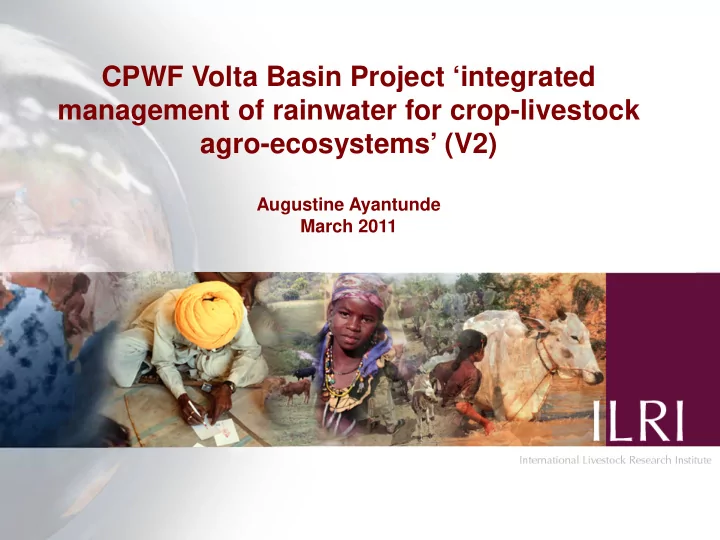

CPWF Volta Basin Project ‘integrated management of rainwater for crop-livestock agro-ecosystems’ (V2) Augustine Ayantunde March 2011
Outline of the presentation Project Data Project Overall Goal & Objective Contribution to Volta BDC Goal Research questions Project Outputs
Project Data • Volta Basin Development Challenge (BDC): Integrated management of rainwater and small reservoirs for multiple uses • Project Title: Integrated management of rainwater for crop-livestock agro-ecosystems • Project lead Organization: ILRI • Project Leader: Augustine Ayantunde • Consortium partners: IWMI, CSIR-ARI Ghana, INERA Burkina Faso, University of Wageningen, Plant Production Systems (WUR- PPS), SNV Burkina Faso • Project Duration: 3 years, 3 months – Oct 2010 to Dec 2013 • Budget from CPWF: US $ 1.225 million
Volta River Basin Overview Countries sharing the basin Benin, Burkina Faso, Cote d’Ivoire, Ghana, Mali, Togo. Basin area 400,000 km2 (Burkina Faso, 43%; Ghana, 40%; Togo, 6%; Benin, 4%; Mali, 4%; Cote d’Ivoire, 3%) Population of the basin : 18.6 million (2000) Percentage rural : Range of 64% - 88% Population below poverty line ($1/day): Burkina Faso, 61.2% (1994); Ghana, 44% (1999); Benin, 37% (2001); Cote d’Ivoire, 37% (1995); Mali, 64% (2001); Togo, 32% Annual rainfall : Variable across basin; 1,600 mm in southeastern portion (Ghana); 400 mm in northern portion (Mali)
Contribution to Volta BDC Goal • Overall Goal of Volta BDC Improving rainwater and small reservoir management in Burkina Faso and northern Ghana to contribute to poverty reduction and improved livelihoods resilience while taking into account downstream and upstream water users including ecosystem services. • V2 Contribution to Volta BDC goal - Increase crop and livestock productivity through best fit Rainwater Management Strategies (RMS) to be identified, evaluated and disseminated - Improve water productivity at farm level - Increase the capacity of various actors through innovation platforms to access and use relevant knowledge on rainwater management
V2 Research Questions 1. What integrated RMS work best where, how, and under which enabling institutional and policy conditions? (output 1) 2. What are the effects of best-fit integrated RMS on different aspects of farm productivity and profitability, gender-specific livelihoods, equity, hydrology, ecosystem services, and vulnerability of people and the environment? And what tools, frameworks, criteria and indicators do we need to assess these effects and combine them in an integrated analysis to come up with targeted solutions? (outputs 2 & 3) 3. How can we foster the adoption, scaling out and scaling up of improved rainwater management practices in mixed crop-livestock agro-ecosystems? Which institutional and policy environments and links to the value chain are needed to ensure adoption by farmers? (outputs 4 and 5)
V2 Project outputs 1. Baseline characterization and inventory of RMS – review of secondary data, baseline surveys, policy and institutional mapping, value chain analysis, inventory workshops 2. Targeted recommendations for different actors and contexts of best integrated RM – participatory action research, multidisciplinary assessments of effects of selected RMS, modeling. 3. Tools, framework for integrated analysis – testing and adapting frameworks, training, guidelines 4. Dissemination and communication of project outputs – rainwater management innovation platforms and learning alliances with multiple actors, project workshops, project briefs, use of existing and new communication tools 5. Capacity building – training students, farmers and learning by rainwater management practitioners through innovation platforms
V2 Project sites Site selection criteria – Agro-ecological gradient along a north-south transect; market access; accessibility to national partners Project site • Northern Ghana 1. Tolon-kumbungu district: 15 km west of Tamale; Rainfall 1000 – 1150 mm; Market access – Very good 2. Lawra district: North-west corner of the Upper West region; Rainfall – 900 – 1000 mm; Market access – Limited. V3 • Burkina Faso 1. Kourbi district: Kadiogo province; Rainfall – 800 mm; Market access – Very good. 2. Ouahigouya district: Yatenga province; Rainfall – 600 mm; Market access: Moderate
V2 Project sites – Selection of Communities Selection criteria – 1. Access to water infrastructures (presence/absence of small reservoirs); 2. Population density (low versus high density); 3. Presence or dominance of crop-livestock systems; 4. Past involvement of projects/NGOs in water management in the communities; and 5. Conflict free community. Villages selected • Northern Ghana 1. Tolon-kumbungu district: Golinga, Bantoroyili, Digu, Gingani 2. Lawra district: Orbili, Berwon, Babile, Naburnye • Burkina Faso 1. Kourbi district: Boussouma, Wamtenga, Kalzi, Komsilga 2. Ouahigouya district: Ziga, Soumyaga, Bogoya, Pogoro
International Livestock Research Institute Better lives through livestock Animal agriculture to reduce poverty, hunger and environmental degradation in developing countries www.ilri.org THANK YOU!
Recommend
More recommend